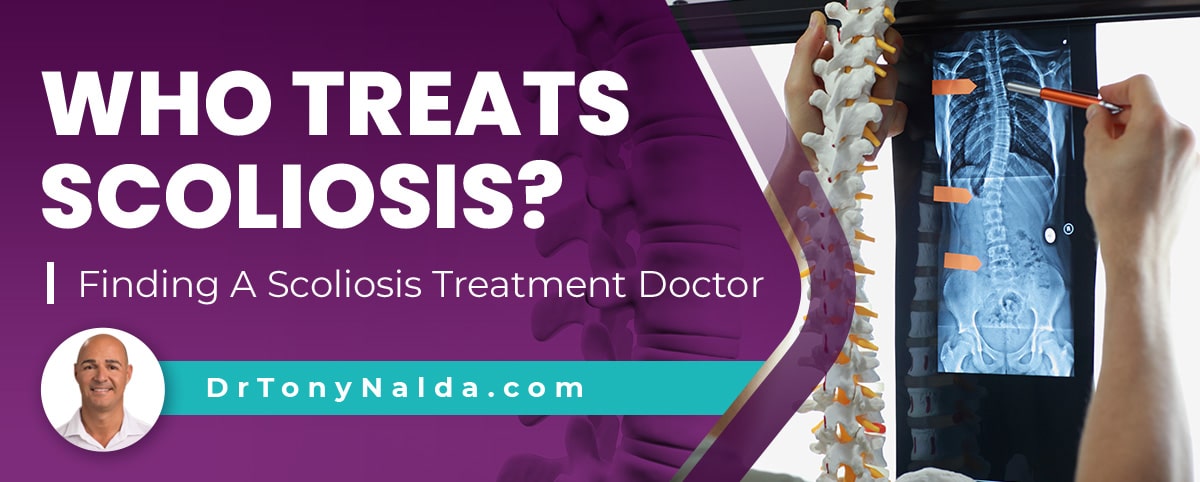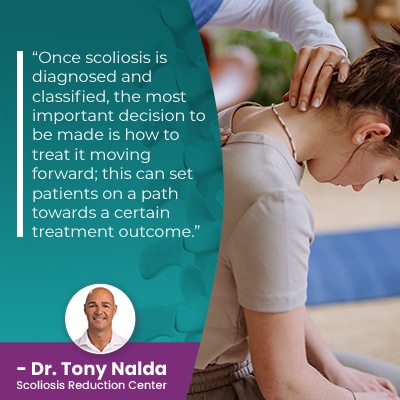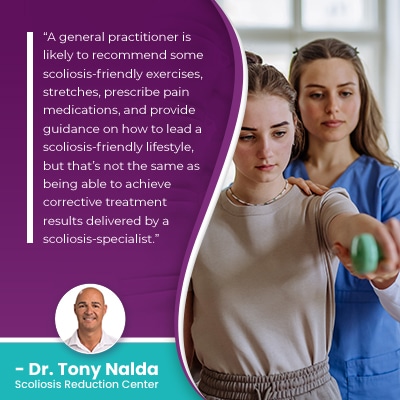Who Treats Scoliosis? Finding A Scoliosis Treatment Doctor

When it comes to finding a scoliosis treatment provider, patients need to understand that as a complex progressive spinal condition, scoliosis is beyond the scope of general medical care and requires the experience and knowledge of a scoliosis-specialist trained in a variety of treatment modalities.
There’s a difference between doctors who treat patients with scoliosis, and doctors who treat the scoliosis itself; this is the difference between receiving general medical treatment or scoliosis-specific treatment. The complex nature of scoliosis necessitates a specialized treatment approach.
Before a treatment approach and provider is decided on, conditions have to be diagnosed and classified, so let’s start there.
Table of Contents
Diagnosing and Classifying Scoliosis
When talking about scoliosis treatment, how it’s diagnosed and classified is important because it highlights why scoliosis can be such a complex condition to treat.
There are a number of spinal conditions that cause a loss of its healthy curves and alignment, but scoliosis is unique in a couple of areas.
Firstly, scoliosis ranges widely in severity from mild to moderate and severe to very severe, and in addition, there are multiple different types of scoliosis with different characteristics, causes, and treatment needs.
The majority of scoliosis cases are classified as idiopathic (approximately 80 percent), while the remaining 20 percent are associated with known causes: neuromuscular scoliosis, degenerative scoliosis, and congenital scoliosis.
So already, you can see why scoliosis requires customized treatment because no two conditions are going to be the same.
So scoliosis involves the development of an unnatural sideways spinal curve that also rotates, making it a 3-dimensional spinal condition: another reason it can be complex to treat.
Part of the diagnostic process includes comprehensive assessment so conditions can be further classified based on key patient/condition variables: patient age, condition type, severity, and curvature location.
Not only can scoliosis develop anywhere along the spine, it can also involve more than one spinal section as a combined scoliosis, or can involve the development of two unnatural scoliotic curves as a double-curve, also known as an S-curve scoliosis.
Curves can bend to the right or the left, and different curvature types and patterns further specify the customization of treatment plans.
 Once scoliosis is diagnosed and classified, the most important decision to be made is how to treat it moving forward; this can set patients on a path towards a certain treatment outcome.
Once scoliosis is diagnosed and classified, the most important decision to be made is how to treat it moving forward; this can set patients on a path towards a certain treatment outcome.
Treating Patients with Scoliosis vs Treating Scoliosis
It can seem like there wouldn’t be a significant difference between what it means to treat patients with scoliosis, or treating scoliosis itself, but it means the difference between treating symptoms of a condition, or the underlying cause of the symptoms: the condition itself.
When it comes to finding a doctor who treats patients with scoliosis, general practitioners can diagnose scoliosis, requisition X-rays to confirm a patient's Cobb angle measurement, can recommend some scoliosis-friendly exercises, provide lifestyle guidance, and can prescribe prescription medications.
But when it comes to finding a doctor who specializes in scoliosis and can craft fully-customized treatment plans based on a number of key patient/condition variables, this falls more within the scope of a medical professional trained specifically in the complexities of scoliosis and scoliosis treatment.
A general doctor can treat patients with scoliosis by addressing their experienced symptoms, but that’s not the same as working towards correcting the actual scoliosis on a structural level.
As a structural spinal condition, the underlying nature of the condition is structural (caused by an abnormality within the spine itself), so in order to be treated effectively, it has to, first and foremost, be impacted on a structural level.
A general practitioner is likely able to recommend some scoliosis-friendly exercises, stretches, prescribe pain medications, and provide guidance on how to lead a scoliosis-friendly lifestyle, but that’s not the same as being able to achieve corrective treatment results delivered by a scoliosis-specialist.
So treating patients with scoliosis can involve prescription pain medications for those experiencing back pain, and when it comes to a progressive condition and pain medications, this can actually be risky by masking the fact that conditions are getting worse.
Scoliosis, however, doesn’t become a compressive condition until skeletal maturity has been reached, which is why the condition is painful for adults, but not so painful for children.
As the condition’s most-prevalent form is adolescent idiopathic scoliosis (AIS), diagnosed between the ages of 10 and 18, we’ll focus on the typical path of treatment for adolescents diagnosed.
Finding a Scoliosis Treatment Doctor
A typical scenario is that a parent notices postural changes in their adolescent so takes them in to see their family doctor for a check up and assessment.
A physical examination will be conducted that involves taking the patient’s medical and family history, observing how a patient holds themselves (posture) and walks, and an Adam’s forward bend test is the gold standard in scoliosis screening exams; this involves examining the spine while the patient is in a forward-bend position, making the spine, its rotation, and any related postural deviation more visible.
If the examination shows indicators of the condition, the doctor will requisition a scoliosis X-ray, and this is needed to truly see what’s happening in and around the spine, and to confirm a patient’s Cobb angle measurement; a minimum Cobb angle measurement of at least 10 degrees is needed to reach a diagnosis of scoliosis.
Now, this is where the path of treatment forks in two different directions because there are two main scoliosis-treatment approaches for patients to choose between, and understanding the difference is important because each offers patients a different potential outcome that impacts quality of life.
At this stage of treatment with a general practitioner, if a patient is diagnosed with scoliosis, they are likely referred directly to an orthopedic surgeon as this is traditional scoliosis treatment, but the reality is that many cases of scoliosis can be treated effectively without invasive spinal surgery.
So this is where finding a scoliosis treatment doctor has to align with the chosen treatment approach, which reflects the type of outcome a patient is looking for, so let’s talk about the main difference between a traditional and conservative scoliosis treatment provider.
Traditional Scoliosis Doctors vs Conservative Scoliosis Doctors
 Traditional scoliosis treatment offers a reactive surgical response; in most cases, if an adolescent is diagnosed with mild scoliosis and are on the path of traditional treatment, they are told to simply watch and wait for signs of further progression, but this is wasting valuable treatment time because as a progressive condition, it’s virtually guaranteed to get worse at some point, and progression makes scoliosis more complex to treat.
Traditional scoliosis treatment offers a reactive surgical response; in most cases, if an adolescent is diagnosed with mild scoliosis and are on the path of traditional treatment, they are told to simply watch and wait for signs of further progression, but this is wasting valuable treatment time because as a progressive condition, it’s virtually guaranteed to get worse at some point, and progression makes scoliosis more complex to treat.
In addition, as growth is the trigger for progression adolescent idiopathic scoliosis patients are at risk for rapid-phase progression due to the stage of puberty with its rapid and unpredictable growth spurts.
So nothing is done to address scoliosis while mild, which is precisely when it’s likely to be the most responsive.
The smaller a curve, the easier it is to correct; as a curve progresses, it gets larger, and the condition’s uneven forces increase, as do their effects.
Progression makes the spine increasingly rigid, making it less responsive to treatment, and this can also make it difficult for some patients to perform certain therapeutic exercises as part of treatment.
So traditional treatment does little to proactively work towards preventing progression, but commonly responds with a surgical recommendation if/when a patient’s scoliosis progresses into the severe classification.
Spinal fusion surgery is a costly and invasive procedure that can cost the spine in terms of its overall health, strength, and function.
A fused spine is contrary to its natural movement-based design, and the main complaint I hear from patients who have undergone spinal fusion is that the loss in spinal flexibility and range of motion has greatly impacted their quality of life.
Conservative Scoliosis Treatment
Here at the Scoliosis Reduction Center, I offer patients a non-surgical scoliosis treatment alternative delivered through a proactive conservative treatment approach.
Conservative treatment values being proactive by starting treatment as close to the time of diagnosis as possible; as a progressive condition, the best time to start scoliosis treatment is always now, so finding the right doctor can mean finding the right treatment approach.
A conservative chiropractic-centered approach involves chiropractors specifically trained in the complexities of scoliosis and scoliosis treatment; while scoliosis treatment is beyond the scope of general chiropractic care, scoliosis-specific chiropractic care, when combined with other effective treatment disciplines, can indeed achieve corrective results.
Corrective treatment results means a curvature reduction on a structural level has been achieved, the spine’s surrounding muscle strength has been improved so the spine can be optimally supported, corrective bracing can help by pushing the spine into a corrective position, and rehabilitation can involve continued chiropractic care and custom-prescribed home exercises to further heal and stabilize the spine.
Conclusion
So who treats scoliosis? While a general practitioner can treat someone with scoliosis, this isn’t the same as seeking the care of a scoliosis-specialist who can treat the condition itself.
As such a highly-complex progressive spinal condition affecting children, treatment plans have to be fully customized to address key patient/condition variables, and those variables will change from patient to patient.
Scoliosis-specialists receive training and certifications in multiple different condition-specific treatment disciplines so they can fully customize treatment plans by apportioning the different disciplines based on how the spine is responding to treatment and growth; this is constantly changing so treatment needs involve constant adjustments.
A traditional scoliosis treatment provider is likely going to funnel patients towards spinal fusion surgery, and this is partially because traditional treatment doesn’t have a strategy for treating scoliosis while mild, so as conditions are being observed and an adolescent growth spurt triggers progression, rapid-phase progression can easily push patients over the surgical threshold.
The reality is that had proactive treatment efforts been applied earlier, an adolescent who has progressed into the severe classification might never have reached that point.
One of the primary goals of the Center’s conservative treatment approach is to help patients avoid the challenges associated with progression, increasing condition severity and symptoms, and the need for invasive surgical treatment in the future.
Dr. Tony Nalda
DOCTOR OF CHIROPRACTIC
After receiving an undergraduate degree in psychology and his Doctorate of Chiropractic from Life University, Dr. Nalda settled in Celebration, Florida and proceeded to build one of Central Florida’s most successful chiropractic clinics.
His experience with patients suffering from scoliosis, and the confusion and frustration they faced, led him to seek a specialty in scoliosis care. In 2006 he completed his Intensive Care Certification from CLEAR Institute, a leading scoliosis educational and certification center.
About Dr. Tony Nalda
 Ready to explore scoliosis treatment? Contact Us Now
Ready to explore scoliosis treatment? Contact Us Now





